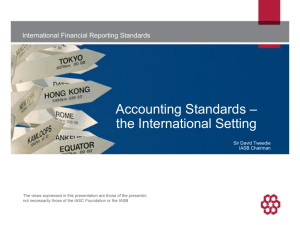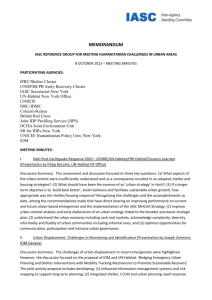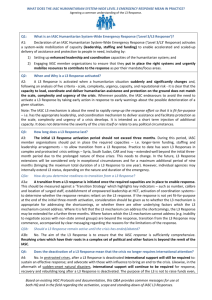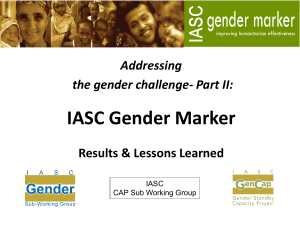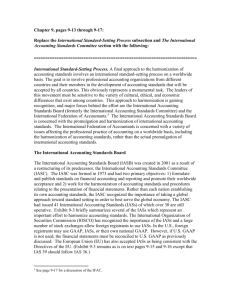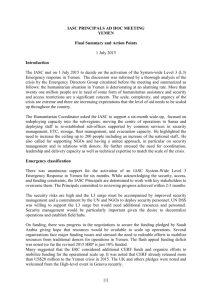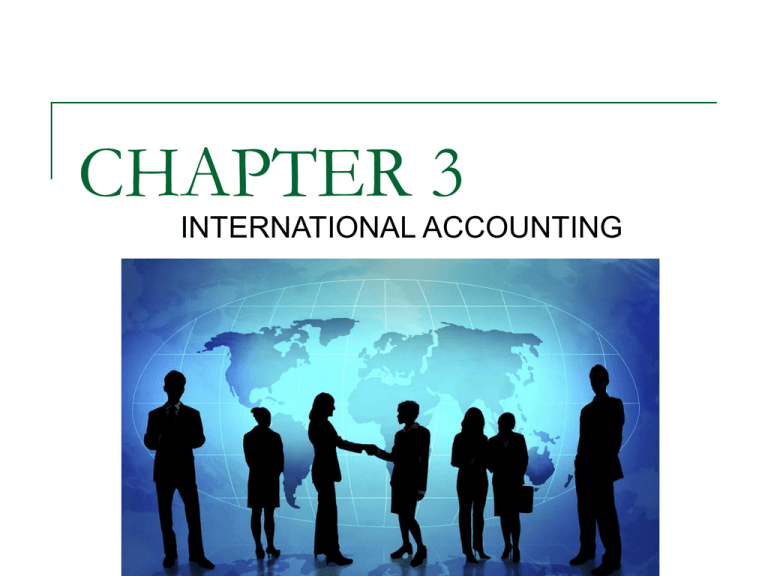
CHAPTER 3
INTERNATIONAL ACCOUNTING
International Accounting
Standards
Financial accounting is influenced
by the environment in which it operates
Companies develop financial reports directed at their
primary users
Previously most were residents of the same country as the
corporation
Transnational financial reporting has become more commonplace
because of the European Union, GATT and NAFTA
U. S. companies must be able to compete in global
markets with transnational financial reporting
International Business Accounting
Issues
A company’s first exposure to
international accounting is
frequently the result of a purchase
or sale
Problems:
1 Exchange gains or losses
2 Obtaining credit information
3 Evaluation of financial statements
Next step may be to open an international division
Another issue is raising capital in foreign markets
Must prepare financial statements in a format acceptable
by appropriate securities market
Factors Influencing the Development
of Accounting Systems:
Level of
Education
Legal
System
Political
System
Economic
Development
Influences on the Development of
Financial Reporting
Type of
economy
Agricultural
Resource Based
Tourist Based
Manufacturing
Legal
System
Codified
Common Law
Political
System
Democratic
Totalitarian
Nature of
Ownership
Private Enterprise
Socialist
Communist
Influences on the Development of
Financial Reporting
Growth
Pattern of
economy
Growing
Stable
Declining
Social Climate
Stability of currency
Sophistication of management
Sophistication of financial community
Existence of accounting legislation
Education System
Spheres of Influence of Current
Accounting Practices
Various attempts at groupings
that have changed in response
to changes in the environment
such as NAFTA and EU
Current groupings
United States
UK/Netherlands
Continental/Japan
South American
Third World
Changing Economies
Communist
Approaches to Preparing Financial
Statements for Use in Other
Countries:
1
2
3
4
5
Same to all
Translate language
Translate language and currency
Two sets
World-wide standards
The International Accounting
Standards Committee
The preparation of financial statements for foreign users
under option #5 is being increasingly advocated
IASC
formed in 1973 to
aid in this process
currently 134
sponsoring
organizations from
104 countries
International
Accounting
Standards Board
replaced IASC in 2001
Standard Setting by the IASC
Original intent:
avoid complex details
concentrate on basic standards
Steps in the process
similar to FASB
1 Steering Committee
2 Identify issues and prepare point outline
3 Board prepares comments
4 Steering Committee prepares final Statement of Principles
5 Exposure Draft
6 Steering Committee reviews comments and prepares final standard
Standard Setting by the IASC
Two treatments
1 Benchmark - point of reference
2 Alternative
Improvements Project
2003
Removed some of the existing alternative accounting
treatments
Where an IAS retains alternative treatments
IASB removed references to 'benchmark treatment'
and allowed 'alternative treatment'
using descriptive references
'cost model'
'revaluation model'
Restructuring the IASC
In its early years, IASC acted mainly as a harmonizer
Recently, it has begun to combine that role with the role of a
catalyst
Harmonizer
Catalyst
Coordinator of national initiatives
Initiator of new work
at national level
Restructuring the IASC
Future IASC role as catalyst and initiator should become
more prominent
Important for the IASC to focus objectives more precisely,
as follows:
1. To develop international accounting standards that require highquality, transparent, and comparable information that will help
participants in capital markets and others to make economic
decisions; and
2. To promote the use of international accounting standards by
working with national standard setters.
Restructuring the IASC
Structural changes needed
so that IASC can anticipate the new challenges facing it and meet those
challenges effectively.
Issues that need to be addressed:
1. Partnership with national standard setters.
IASC should enter into a partnership with national standard setters
so that IASC can work together with them to accelerate
convergence between national standards
and international accounting standards around solutions requiring highquality, transparent, and comparable information
that will help participants in capital markets and others to make
economic decisions.
Restructuring the IASC
2.
Wider participation in the IASC Board.
A wider group of countries and organizations should take part in the
IASC Board
3.
Without diluting the quality of the Board's work
Appointment.
The process for appointments to the IASC Board and key IASC
committees should be the responsibility of a variety of
constituencies
Must that those appointed are competent
Restructuring the IASC
2001:
Responsibility for international standardssetting was transferred to the to the
International Accounting Standards
Board (IASB)
Restructuring the IASC
The following changes were adopted:
1. Steering Committees replaced by a Standards Development Committee
National standard setters will play a major role in developing international
accounting standards for approval by the IASC Board
Standards Development Committee will also be responsible for approving
the publication of final SIC Interpretations prepared by the Standing
Interpretations Committee
2. Standards Development Committee supported by a Standards
Development Advisory Committee
Acts as a channel of communication with those national standard setters
who are unable to participate directly in the Standards Development
Committee because of its limited size
Restructuring the IASC
3.
IASC Board expanded from 16 to 25 countries and organizations
4.
Without diluting the quality of the Board’s work
Advisory Council was replaced by 12 Trustees
Three appointed by the International Federation of Accountants
Three by other international organizations
Six by the Trustees to represent the world "at large"
Trustees appoint members of the Standards Development
Committee, the Board, and the Standing Interpretations Committee
Trustees also have responsibility for monitoring IASC’s effectiveness
and for financing the IASC’s activities
Restructuring the IASC
The new structure:
The IASC Foundation
The International Accounting
Standards Board
The International Accounting
Standards Advisory Council
International Financial Reporting
Interpretations Committee
KEY:
New Structure
Appoints
Reports To
Advises
IASC Foundation
19 Trustees Appoint, Oversee, Raise Funds
Board: 12 Full time & 2 Part Time
Set Technical Agenda
Approve Standards, Exposure Drafts, &
Interpretations
Standards
Advisory Council
49 members
Advisory Groups
For Major Agenda Projects
International Financial
Reporting
Interpretations
Committee
(12 members)
Revising the IASB’s Constitution
Key issues to be reviewed:
1. Whether the objectives of the IASC Foundation should
expressly refer to the challenges facing small and mediumsized entities (SMEs)
2. Number of Trustees and their geographical and professional
distribution
3. The oversight role of the Trustees
4. Funding of the IASC Foundation
5. The composition of the IASB
6. The appropriateness of the IASB's existing formal liaison
relationships
7. Consultative arrangements of the IASB
8. Voting procedures of the IASB
9. Resources and effectiveness of the International Financial
Reporting Interpretations Committee (UMC):
10. The composition, role, and effectiveness of the SAC
The Uses of International
Accounting Standards
IASC noted that its standards are used in a variety of
ways:
1 National requirements
2 Basis for national requirements
3 Benchmark to develop standards
4 By regulatory agencies
5 By companies
Also International Organization of Securities Commissions
(IOSCO) looks to the IASC to provide standards that can
be used in multinational securities offerings
Current Issues
Partnership with the IOSCO
Generate standards acceptable to IOSCO
December 17, 2003
IASB published 13 revised International Accounting Standards
Reissued two others
Gave notice of the withdrawal of its standard on price level
accounting.
Revised and reissued standards mark near-completion of
the IASBs Improvements project
Issues to Be Addressed by Standard
Setting Bodies in Various Countries
Until recently, little impact in U. S.
Standard setters will need to focus on following questions:
1 Can international accounting standards be set voluntarily by
organizations representing a broad set of sovereign nations?
2 What is the impact on standard setting of differing economies and social
settings in various countries?
3 Can lessons be learned from other international world bodies with
sovereign members having experience in bringing conflicting national
laws into harmony?
IFRS No. 1: First-time Adoption of International
Financial Reporting Standards
More than 90 countries will either require or permit the
use of IFRSs during the next several years.
As a result, thousands of companies throughout the world will
be making a transition in financial reporting by breaking away
from national practices
and changing to accounting standards
set by the IASB.
The IASB issued IFRS No 1 to aid
in this process
FASB Short-term International
Convergence Project
The goal of this project is to remove a variety of
individual differences between U.S. GAAP and
International Financial Reporting Standards that are not
within the scope of other major projects.
The project scope is limited to those differences in which convergence
around a high-quality solution would appear to be achievable in the
short-term, usually by selecting between existing IFRS and U.S. GAAP.
The Norwalk Agreement
12/18/2002:
FASB and IASB held joint meeting in Norwalk, Connecticut
Both standard setting bodies acknowledged…
their commitment to the development of high-quality compatible
accounting standards that can be used for both domestic and
cross-border financial reporting.
Also committed to use their best efforts to make their existing
financial reporting standards compatible as soon as
practicable and to coordinate their future work programs to
help ensure that once compatibility is achieved, it will be
maintained.
The Norwalk Agreement
Both Boards agreed to:
1. Undertake a short-term project aimed at removing a variety of
differences between U. S. GAAP and IFRSs.
2. Remove any other differences between IFRSs and U. S.
GAAP that may remain on January 1, 2005 by undertaking
projects that both Boards would address concurrently.
3. Continue the progress on the joint projects currently underway.
4. Encourage their respective interpretative bodies to coordinate
their activities.
The Roadmap to Convergence
2005 agreement between FASB & IASB:
Convergence best achieved with high-quality, common
standards
Develop a new common standard rather than try to eliminate
differences
Replace weaker standards with stronger standards
2008 Convergence Goals
Should major differences be eliminated?
Joint projects: 11 areas of focus
International vs. GAAP
Accounting Standards
Question: Should foreign companies be
allowed to list
their securities in United States markets
Form 20-F reconciliations
Pressure on the SEC to accept
international accounting rules
The Financial Statement Impact of
International Accounting Standards
FASB project:
Purpose of analysis
1 Identify similarities and differences of the IAS
standard and U. S. GAAP
2 Assess the impact of these similarities and
differences and their relative significance
3 Include examples wherever possible
Framework for the Preparation and
Presentation of Financial Statements
Purpose - to set out concepts that underlie the preparation
and presentation of financial statements by:
1
2
3
4
5
Assisting the IASC in developing future standards
Promoting harmonization of accounting standards
Assisting national standard setters
Assisting preparers in applying international standards
Assisting auditors in forming an opinion as to
whether financial statements conform to
international standards
6 Assisting users in interpreting financial
statements prepared in conformity with
international standards
7 Providing interested parties with information
about the IASC’s approach to the formation
of international accounting standards
Framework for the Preparation and
Presentation of Financial Statement”
The Framework specifies:
1
2
3
4
Objective of financial statements
Qualitative characteristics
Elements
The concepts of capital maintenance
The Objective of Financial
Statements
Information useful in making economic decisions
General purpose financial statements
The framework indicated that:
1
Users require evaluation of the ability of an enterprise to generate cash and the timing
and certainty of that generation
2
The financial position of an enterprise is affected by the economic resources it controls,
its financial structure, its liquidity and solvency and its capacity to adapt to change
3
Information on profitability is required to assess changes in the economic resources an
enterprise controls in the future
4
Information of the financial position of an enterprise is useful in assessing its investing,
financing and operating activities
5
Information about financial position is contained in the balance sheet and information
about performance is contained in the income statement
The Objective of Financial
Statements
Underlying assumptions for the
preparation of financial statements
1 Accrual basis
2 Going concern
Qualitative Characteristics
Attributes that make accounting information
useful
1
2
3
4
Understandability
Relevance
Reliability
Comparability
Also recognized that timeliness and a
balance between costs and benefits were
constraints
The Elements of Financial Statements
Asset
Liability
Equity
Income
Expense
The concept of recognition
– Probable
– Measurable
The Concepts of Capital Maintenance
Concepts:
1 Financial capital maintenance
2 Physical capital maintenance
Selection of the measurement bases and the
concept of capital maintenance chosen will
determine the accounting model
IASC does not intend to prescribe a model
Current Developments
2005 joint agenda project
Goals: converge existing
frameworks into common
framework
Standards should be
principles based, rooted in
fundamental concepts
IAS No. 1 “Presentation of Financial Statements”
Considerations:
a
b
c
d
e
f
g
h
Fair presentation and compliance with IASC standards
Accounting policies
Going concern
Accrual basis of accounting
Consistency of presentation
Materiality and aggregation
Offsetting
Comparative information
FASB staff review
IAS No. 1 “Presentation of Financial Statements”
2003 Amendments
“Presents fairly” definition
Elaboration of “misleading” results
from complaince
Standards on selection of accounting
policies moved to IAS No. 8
Certain disclosures no longer
required
Specific disclosures required
Statement of Changes in Equity
disclosure requirements
IFRS No. 1 “First Time Adoption of International
Reporting Standards”
Compliance requirements
Recognition of assets and liabilities
Only when required by IFRSs
Requires reclassifying if necessary
Applies existing IFRSs in measuring
Prepared by Kathryn Yarbrough, MBA
Copyright © 2009 John Wiley & Sons, Inc. All rights reserved.
Reproduction or translation of this work beyond that permitted in
Section 117 of the 1976 United States Copyright Act without the
express written consent of the copyright owner is unlawful. Request
for further information should be addressed to the Permissions
Department, John Wiley & Sons, Inc. The purchaser may make backup copies for his/her own use only and not for distribution or
resale. The Publisher assumes no responsibility for errors,
omissions, or damages, caused by the use of these programs or from
the use of the information contained herein.

